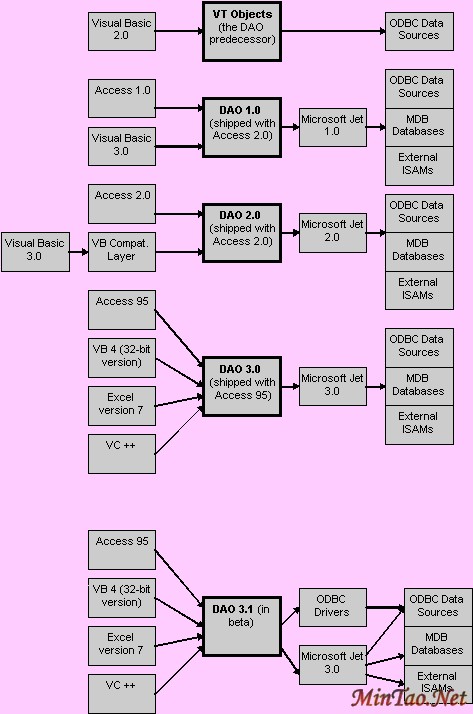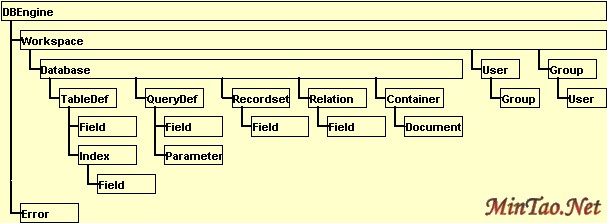|
DAO Advanced Programming
by Dan Haught
Vice President of Product Development
http://www.fmsinc.com
Introduction
Data Access Objects, or DAO, is a powerful programming model for database services. Originally designed as an ODBC layer for Microsoft Visual Basic version 2.0, DAO has evolved into a model that encompasses Microsoft Jet and ODBC, and in the future, OLEDB. This session covers advanced topics in DAO programming that will give you the tools you need to become an advanced programmer using the DAO model.
This session is of primary value to developers creating database applications using Microsoft Access, Microsoft Visual Basic, Microsoft Excel, or Microsoft Visual C++.
Some of the material here is based on work done for the "Microsoft Jet Database Engine Programmers Guide" from Microsoft Press (ISBN 1-55615-877-7). This book is the most complete reference for DAO and Jet programming.
The following topics will be discussed:
- A Quick Overview of DAO
- Object Creation and Modification
- Working with Data
- Developing an Object Dictionary
- Semi-Documented Tools and Resources
- Wrapping Up
Back to Main Technical Papers Page
Copyright 1996 FMS, Inc. All rights reserved

A Quick Overview of DAO
Up until DAO 3.1, DAO was defined as:
"The Programmatic Interface to Microsoft Jet".
Jet is the database engine used by Microsoft Access and Microsoft Visual Basic. DAO has historically been synonymous with Jet, in that Jet was the database engine that it mapped to. As of DAO version 3.1, an important change has occurred. DAO 3.1, through the ODBC-Direct extensions, offers for the first time the ability to completely bypass Microsoft Jet. It is because of this important new functionality that at a conceptual level, DAO is no longer tied to Jet. It is now defined as:
"A Programmatic Interface for Database Services"
Where Can I Use DAO?
DAO is available as a programming tool in to following development environments:
- Access 2.0
- Access 95 (version 7)
- Microsoft Visual Basic (version 4)
- Microsoft Excel (version 7)
- Microsoft Visual C++
- Any development environment that can use an OLE Typelib
How Do I Get DAO?
The DAO components are available in:
- Access 2.0
- Access 95 (version 7)
- Microsoft Visual Basic (version 4)
- Microsoft Excel (version 7)
- Microsoft Visual C++ (version 2.01 and later)
- The DAO SDK ships with the book "Microsoft Jet Database Engine Programmers Guide" from Microsoft Press
How Does DAO Licensing Work?
If your application''''s users have any of the following products installed on their workstations:
- Microsoft Office 95
- Visual C++
- Microsoft Excel version 7
- Microsoft Access version 7
- Microsoft Visual Basic version 4 (32-bit)
then they can use both the DAO part of your application and DAO to write their own applications without restrictions. If your application''''s users don''''t have any of these products installed, then they can only use DAO in the context of your application. They cannot use DAO to write their own applications by using the DAO component you ship with your application.
A Brief History of DAO
DAO had its genesis as a part of Visual Basic 2.0 known internally at Microsoft as "VT Objects". This component allowed ODBC access with a very limited set of options. With the November 1992 introduction of Access 1.0, DAO entered version 1.0 status, and allowed Access developers to use a limited set of database objects in a Microsoft Jet database. With version 2.0 of DAO, as introduced by Access 2.0, a much fuller object model was available. There was almost complete control over creating and modifying objects, and opening a variety of recordset types against data. Additionally, the concept of programmatic security control was introduced. The first 32-bit version of DAO was created soon after for the ODBC desktop driver pack introduced by Microsoft. Then, in 1995, DAO 3.0 was introduced with Access 95 and VB4 simultaneously. This version offered a full 32-bit typelib and added new properties and methods to round out the object model. In addition, a new Error object was added to allow easier access to runtime errors. DAO 3.1 was in beta status as of the writing of this paper, and its release date is uncertain. DAO 3.1 represents the first break with Microsoft Jet. Since version 3.1 allows direct access to ODBC data sources through its ODBC-Direct functionality, DAO is no longer only an interface to Jet. In the future, DAO will be the programmatic object model for OLE DB.
The following diagram illustrates the evolution of DAO.
`
Why Use DAO?
DAO is a well-known, easy to use object model for database services, including Microsoft Jet, ODBC, and in the future, OLE DB. DAO is also multi-lingual-you can use it from VB and VBA environments, FoxPro, and Visual C++. Your knowledge of DAO allows you to access a variety of data sources from a variety of development environments. DAO is also Microsoft''''s strategic object model for Database Access. Therefore, you can assume that it is going to be around for a long while.
The DAO Model
DAO is implemented as a hierarchy of objects and collections. Each of the object types is represented within this hierarchy. The following diagram illustrates the model:

Objects and Collections
Most object types have a collection that acts as a holder for all the objects of that specific type. For example, each the QueryDefs collection holds all QueryDef objects in the database. The following syntax is used to refer to objects in a collection:
Collection!name or Collection![Name]
Collection("name")
Collection(expression) where expression is a variable or other expression
Collection(index) where index is the number of the object''''s position within the collection.
Traversing collections
You can traverse or iterate through a DAO collection [1] [2] [3] [4] [5] 下一页
[常用软件]Dao ne Deepnet 三合一的浏览器 浏览器 [Web开发]DAO RDO ADO ADO.NET
[Sql Server]ASP编程入门进阶(廿一):DAO SQL之建立数据库表
| 















